A resource management game where players create a supply chain and ship goods.
60-120 minutes
Designer: Uwe Rosenberg
Artist: Klemens Franz
Publisher: Lookout Games
It’s time for an Uwe game! This review is brought to you by a Twitter poll asking which “older” game (published 10+ years ago) deserves a resurgence of attention. There’s a reason Le Havre has about a million awards since its debut in 2007, and in this review we’ll talk about why we agree with Twitter (on this at least).
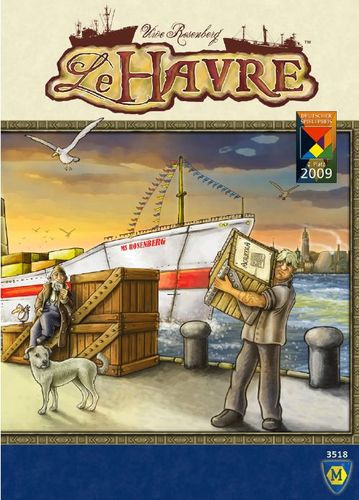
Gameplay Overview
This is a general overview to provide context for the review, not an in-depth how to play. Some rules may be glossed over or missing.
Setup
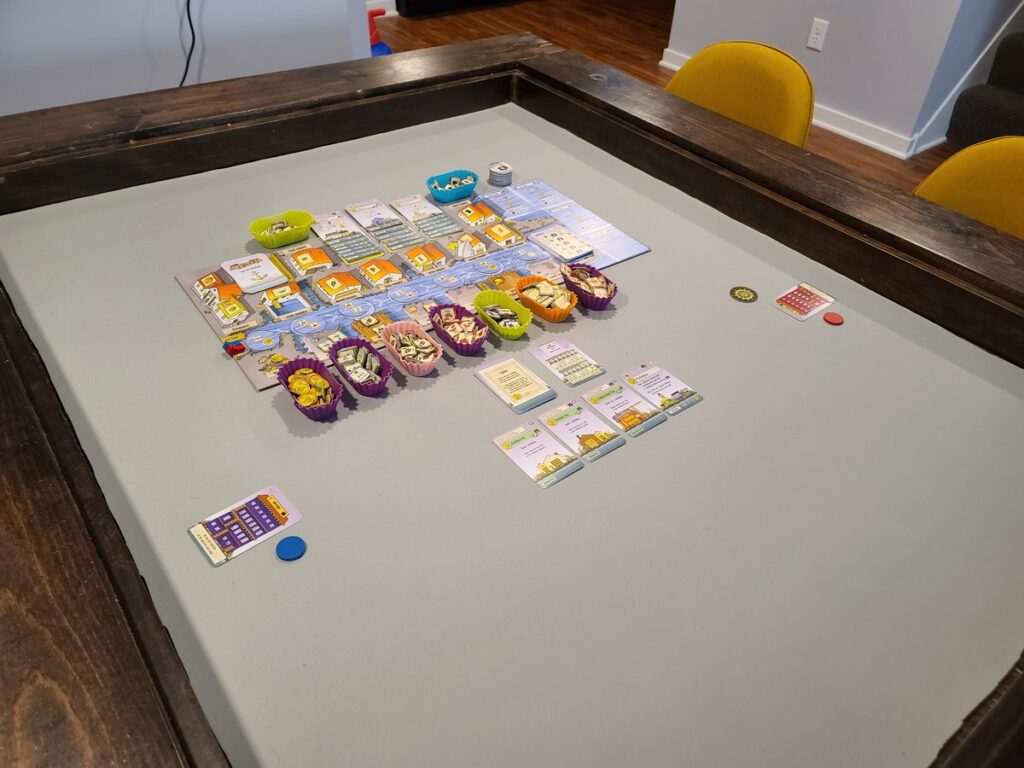
There’s almost more to the setup of Le Havre than there is to the actual gameplay, but that also is what gives it the replayability.
Some key elements of setup are:
- Split the building cards evenly into 3 decks, then arrange each deck face-up from lowest to highest number (so lowest number is on top) on the central board. The top card of each stack is available to build or for purchase
- Shuffle turn marker spaces, then place face-down on the central board
- Decide on short vs. long game and sort out round cards as needed
- Place 3 starting buildings in the “village” in the center of the table. Depending on player count, there may be additional buildings to star
Game Flow
Le Havre is extremely approachable and is one of the more straightforward medium-heavy games we have covered on our site so far.
The number of rounds varies by player count and by whether you choose the short or long game. A 2-player long game has 14 rounds, the short game has 7 rounds. No matter the player count, each round has exactly 7 turns. This round structure means that each player will have an uneven number of turns per round and the starting player automatically changes each round. For example, in a two player game the starting player will have 4 turns in the first round while the second player has 3 turns. The next round will begin with the second player’s 4th turn.
Pro tip: this means in a two-player game, the second player will have the advantage of 4 turns in the final round. Do you want the advantage early or late?
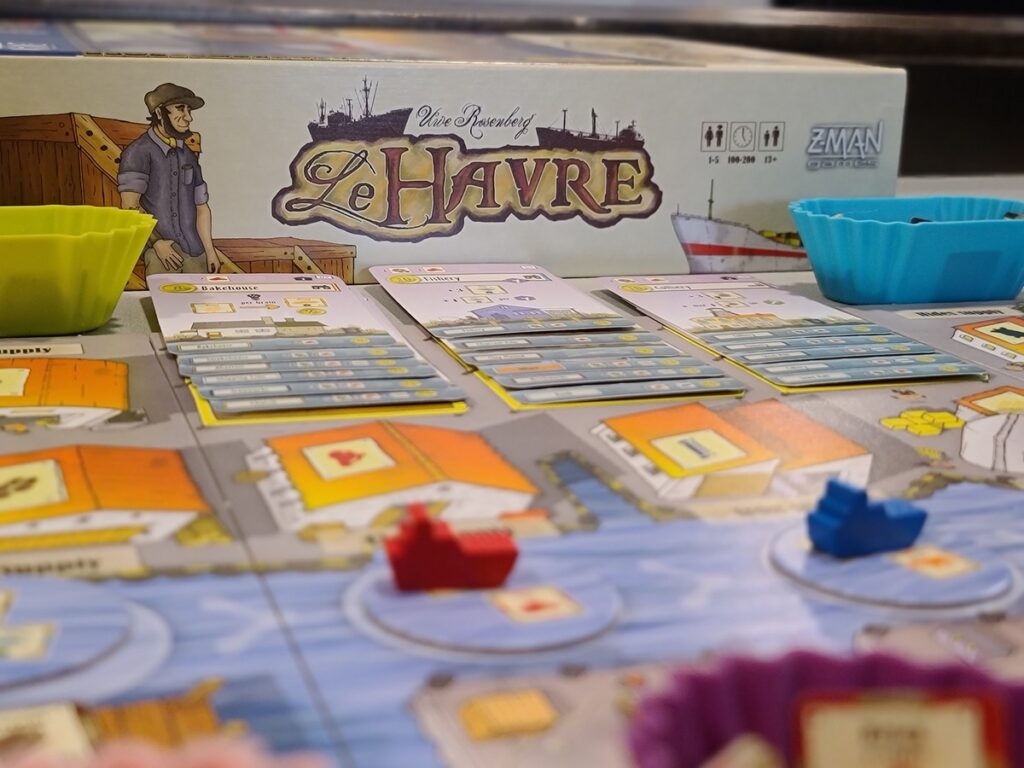
A Turn
A turn in Le Havre consists of 2 steps:
- Move your ship to the next open space (leapfrogging other ships) and deliver the shown resources to the central board
- Main Action
- Take all of one offer (resources) from the central board
- Move worker disc to ANY building as long as there is no worker on it
- Pay the indicated cost (if any) to enter the building. Do not pay for your own buildings
- Perform the building action
Anytime Actions
At any time during your turn, you may also:
- Buy a building or ship
- Sell a building or ship for half its value
- Repay a loan
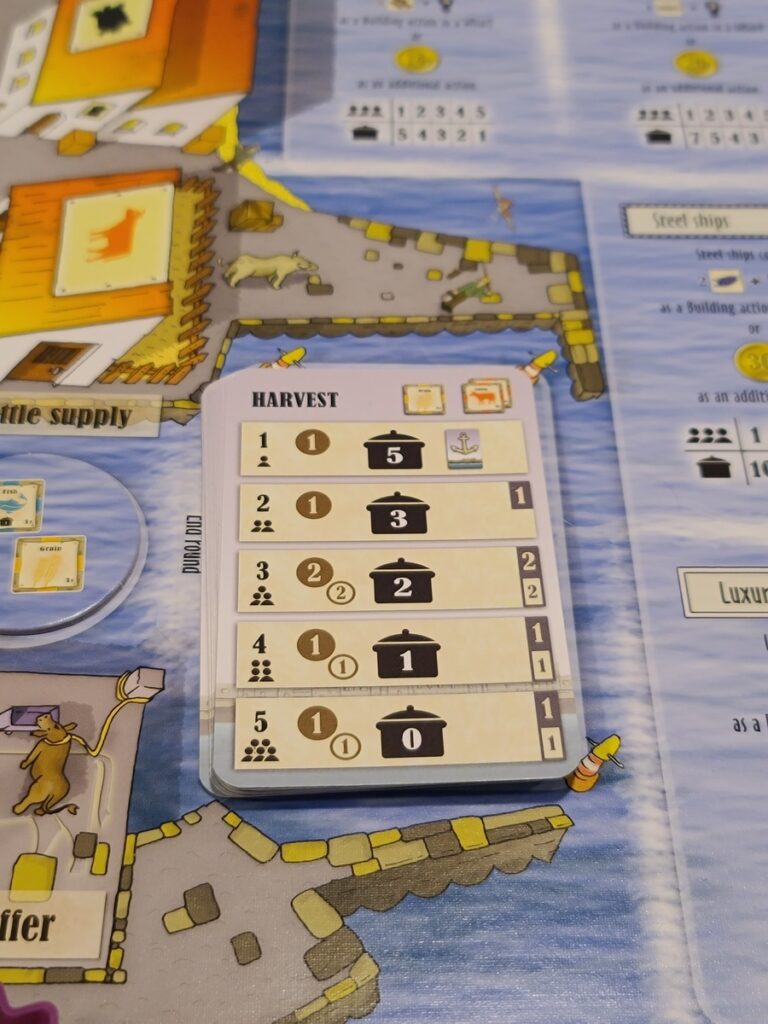
End of Round
As soon as any player reaches the seventh round marker and completes their turn, the round ends.
Note: Only one player needs to reach the seventh space.
Players will do a harvest action in most rounds where they take 1 grain if they have any grain and 1 cow if they have more than 2 cows.
It’s an Uwe game, so duh, then you have to feed your people. Each round requires more and more food – a key element to your strategy! Unlike other Uwe games, you have no control over the total amount of food “due” (each player must pay the same), but you have a number of ways to come up with it.
After you are done feeding, flip over the round card to reveal the ship on the other side. The ship is now available to be built in the next round as long as the wharf is out.
End of Game
The game has a set number of rounds that varies by player count and whether you chose a long game or short game. The round number is displayed on the round cards, and there is a summary card available for each player count that shows anything that might be unique about that round.
The player with the most money, including the monetary value of their buildings, wins.
Pro Tip: Always keep in mind that the end game score is money and the monetary building value. If you’re spending money and time to set up a sweet clay engine, make sure you’ve got a plan for what to do with that all that clay and that the math works out in your favor. It’s easy to get caught up in building an engine and forget that spending all your money on a cool building might not pay off in the end.
What do we think?
Le Havre is one of the most approachable “heavy” games out there. The decision tree for each turn is small, you either take resources or use a building, but planning is so crucial that every decision you make has consequences and benefits.
It’s proof that a game doesn’t need super complex rules to have complex strategy. It is HARD to balance getting resources build buildings with having enough food. Sarah takes the approach of letting herself take loans early in the game to feed so that she can focus on building an engine, whereas Emily feeds to avoid the financial hit of a loan and builds her engine slowly.
The variable setup means you have to adjust your strategy every time you play, since different buildings will be available at different times. Luckily, you can always see what’s coming up when, so part of your strategy might be to get buildings from a certain pile out faster to reveal a key building (like the Wharf to build ships).
This game says 1-4 players, but we would never play this at 4. The number of turns between round end doesn’t change from 7 and while the 4 player game has more rounds to compensate, we know we (**Emily**) would be way too stressed out. General consensus on the internet is that 2 or 3 player is ideal.
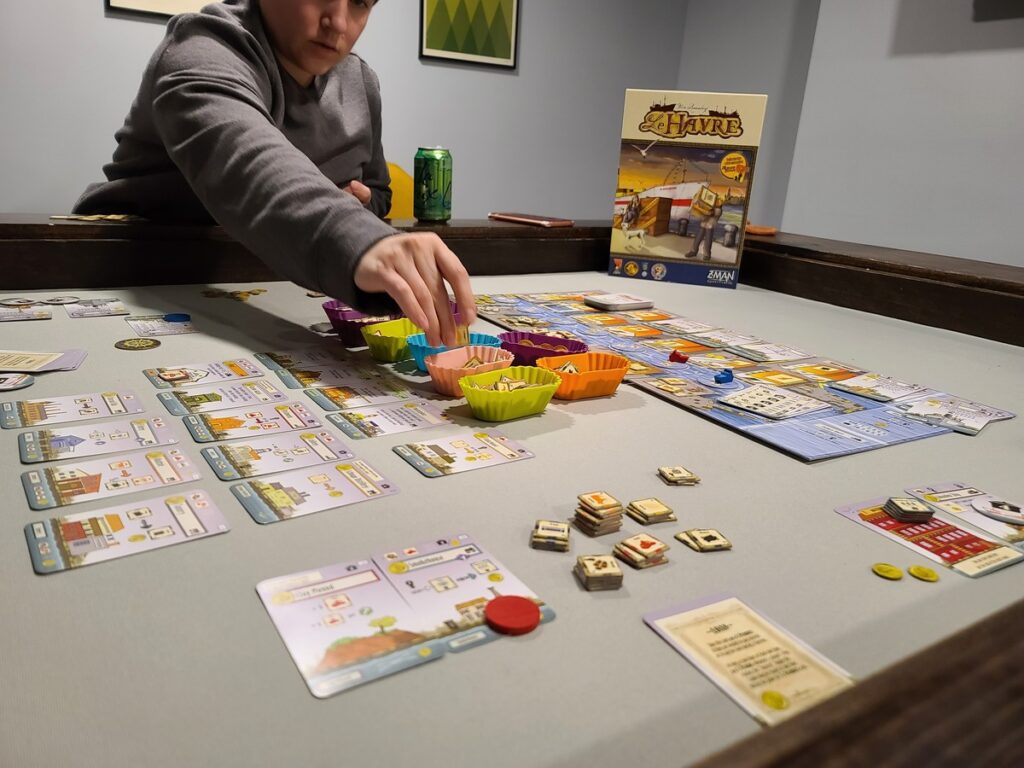
What did we like?
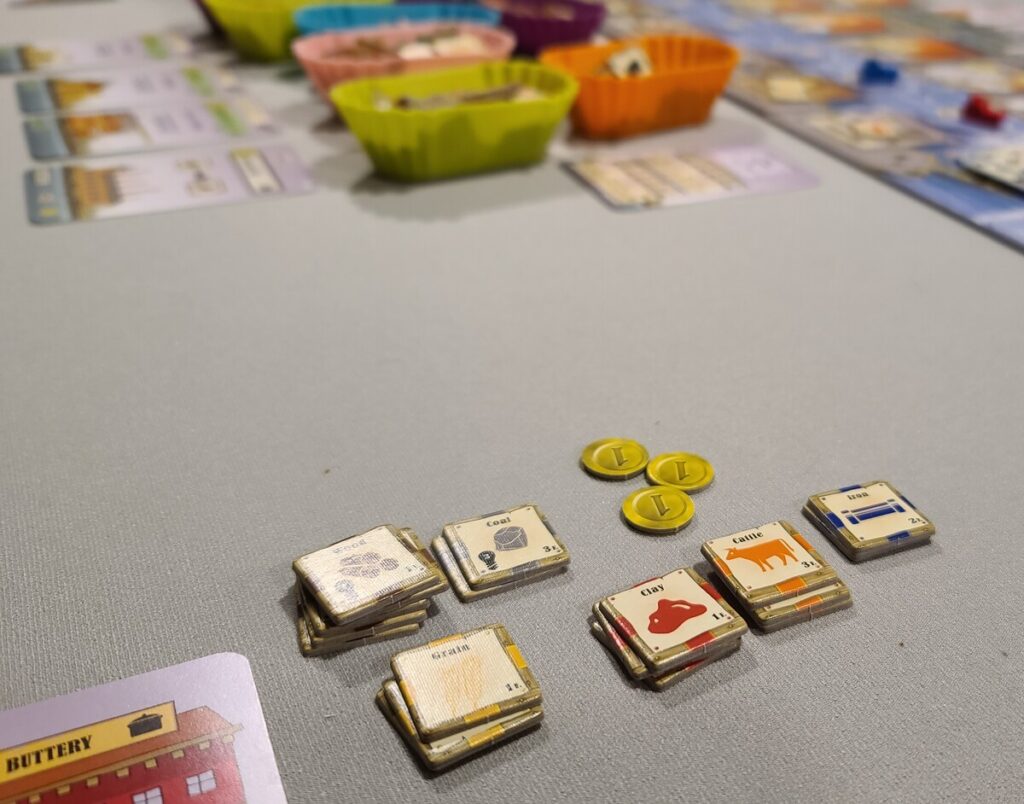
We are big fans of getting a bunch of resources to turn them into other resources that allow you to get other things. Even pretty early on you’ll likely have a pile of resources you’re saving for some cool move in a few turns.
Le Havre also stands out from other resource-heavy engine building games in that you get to actually USE and evolve your engine (in the long game). Countless games end just as you feel like you get going, but in Le Havre you’re raking in that sweet sweet coal or whatever from mid-game on, adding on components of your engine (turn coal into coke – not that kind – then ship it for big bucks). That’s a really satisfying feeling.
It also scales super well and we love the option of short vs. long game. Gameplay is excellent at 2 players.
What didn't we like?
Game Length: The full game is a loooong game. It can take several rounds to really get going and you do get to a point where you’re thinking “I have a ton of resources but I can’t do anything because I have to feed my bleeping workers!!!!” It’s part of the game and evens out to be very satisfying, but the beginning can be a bit slow.
Board Layout/ Components: We don’t love the board layout or the pieces. There are a lot of tokens in this game and it can be a huge mess. Fun fact: toddlers love messing up tables with a lot of tiny pieces. Don’t leave this set up to come back to later if toddlers are afoot.
Technically the token supplies are supposed to go on the board but it ends up looking like a mess and we spend as much time organizing little piles as we do playing the game. We keep all the resource supplies in little cupcake liners near the board (instead of making piles in the designated board spaces) and only put the available offer on the board.
Pro tip: You’ll be putting on and taking off a lot of tokens during a play of Le Havre. It’s best to make sure that you can comfortably reach everything.
Who will like this game?
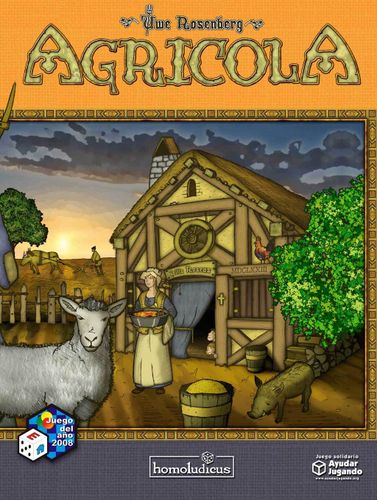
This is a relatively straightforward medium-heavy weight game. The clear, easy to follow rules make it more approachable to someone newer to this type of game, but the complex strategy keeps it engaging for experienced players. Overall this game is well-balanced and based on the number of awards and reviews over the past decade, it has a wide appeal.
Le Havre has a very similar feel to other Uwe games like Agricola or Ora et Labora.
Sarah's Take
I’ve always been a fan of restriction in games. The stress of having to establish a food engine or farming to be able to consistently feed your family is one of my favorite “game feelings”. Finding and quickly establishing efficiencies is my jam and Le Havre has it in spades. Each game is a new challenge to establish a new strategy. Sure, the same general strategy may work well enough over and over, but the depth and joy of Le Havre comes from really understanding the buildings and making synergies with the how the resources are distributed to the buildings available.
Emily and I are generally very close in scores during Le Havre too. She always thinks that she’s crushing me but in the end it’s much closer than she thinks.
Emily's Take
I’m going to be honest, this isn’t one of my favorites. It’s fine, I’ll play it if Sarah really wants to, but there are other 60min or so medium-heavy games I’ll go to before this one. If I’m choosing between restrictive games, though, I’ll pick this one over the base game of Agricola. There’s more subtlety and nuance to the strategy in Le Havre, and the setup means each game can be very different in terms of your best early game moves.
Sarah likes to note that our scores are typically close in Le Havre, but she fails to mention that I’m on a winning streak in general.
Breakdown
Rulebook / Learning the game
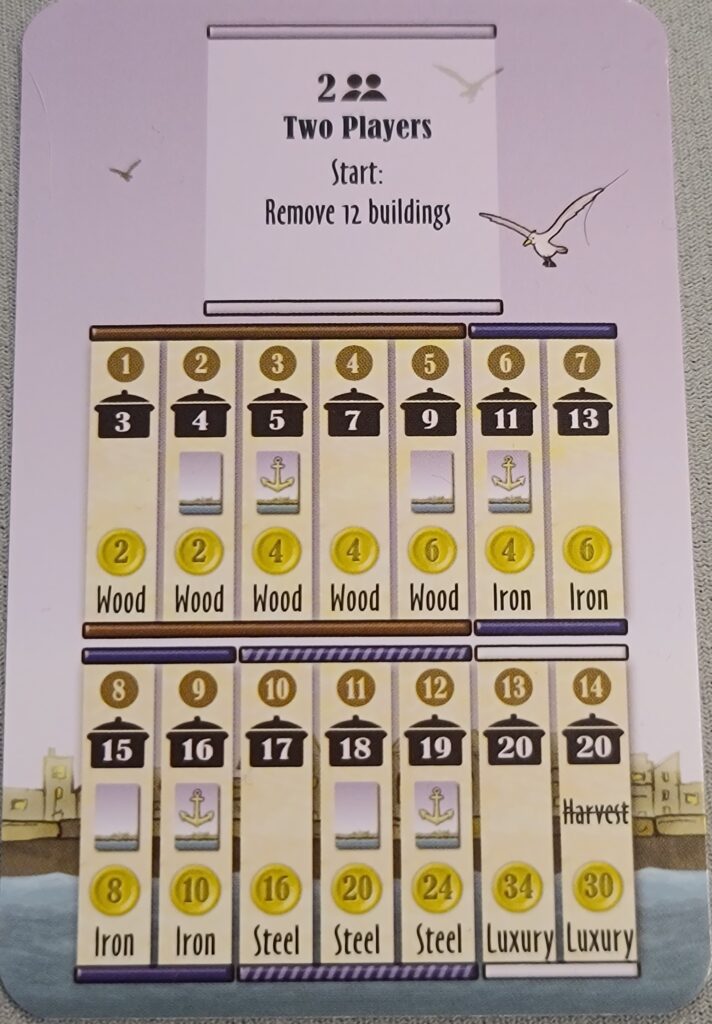
We first learned Le Havre about 5-6 years ago as we started getting into heavier games. At the time, we learned from the rulebook and don’t recall any major concerns. Revisiting the game now, we were able to quickly go through the rulebook with no issues. Everything is clearly laid out, with examples. There’s a separate references rulebook for the buildings that is really helpful.
There are round overview cards, too, that tell you what is coming up in future rounds based on the number of players and short vs. long game. For example, it shows the amount of food you’ll have to play or the type of ship that will be coming up.
First Play
While we don’t 100% recall our first play of Le Havre, we know that we played the shortened game as a learning game. Revisiting Le Havre several years later, we jumped right back into the long game and it took several plays to get our feet under us, so to speak, before the strategy clicked again. The beginning of the game has a frantic feel if you aren’t sure about your long-game strategy, so play enough that you can get past that and see the bigger picture. That’s where the fun comes in!
Subsequent Plays
While we say that the rules of Le Havre are approachable, the strategy is a whole other thing. It definitely takes several plays to really understand how all the buildings work together and how to maximize your one action each turn. If you’re someone that loves efficiencies, you’ll really enjoy coming back to Le Havre and trying to improve upon each game.
Parent Perspective
Interruptions
Le Havre really thrives on long term planning and strategy. This makes it fairly friendly to interruptions. It’s easy to predict where and when resources will be available, and at any given moment you are generally planning 3-5 turns ahead.
Time Investment
Set up and clean up can be involved if you’re not organized. We skip placing supply piles on the board as the rules indicate and instead keep them in little cups to the side of the board with only the actual offer going on to the board. We typically plan on a full two hours for Le Havre – a little more than 90 minutes of gameplay (if one of both of us actually has a plan), and about 10 minutes on either side dedicated to set up/clean up.
Life Fit
If you’re organized or have the ability to set up ahead of time, it’s possible to fit Le Havre in on a weeknight. It’s firmly in the weekend category for us just due to set up and clean up.
Rating
7.5/10
Another game we disagree on the rating for this one. Sarah would give it a 8 easily, Emily more like a 7. It’s a great introduction to heavier games that is a really fun efficiency puzzle, is probably best at 2 players, and so much replayability in the variable set up. The approachable yet deep strategy make Le Havre accessible to folks just getting into heavier weight games, yet still very enjoyable for people that have several plays under their belt.
*See our rating scale HERE
Click through for more posts, or follow us on social media to see what we’re playing and for new post updates!
